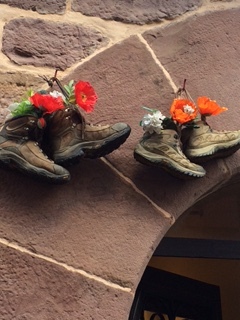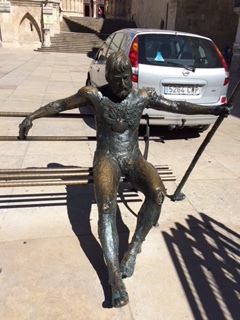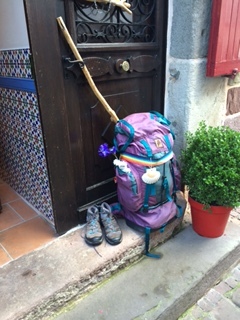A Short Walk Along the Camino: Following the Camino de Santiago on A Pilgrim's Way
A Short Walk Along the Camino: Following the Camino de Santiago on A Pilgrim's Way
By Sarah Franklin
Recently, I had the privilege of going on Discover Europe’s trip, A Pilgrim’s Way, that follows the Camino de Santiago, the road to Santiago, or Way of St. James. During the middle ages, to guarantee remission of their sins, pilgrims walked from many points in Europe all the way to Santiago to throw their bodies down in front of the remains of Saint James the Apostle, for redemption. Gavin Miller, our tour guide, informed us from the start, that the path of the pilgrimage actually goes back to prehistoric times when man sought the edge of the world as North West Spain was thought to be the end of the earth as its name, Finisterre, implies. This path, eventually used by the Romans, was along what are known as “Ley Lines”, or electromagnetic energy pathways, said to have healing qualities. This trip not only provided insight into the experience of many pilgrims who have made this walking trip over the centuries, at one point 500,000 per year, but also gave me a taste of questing for spiritual connection and inner peace
One of our first stops was at one of the most popular starting points, St Jean de Pied du Port, just over the border in France. Here a pilgrim can get a bed at an Auberge, or hostel, for 6-10 euros before setting off on their trek of 500 miles to Santiago. If they set off too fast, the chances of burnout are high, therefore the Camino must be walked slowly, we were informed. Walking 10-15 miles per day is the recommended amount, although we met young people who sometimes walked 30-40 in a day.
“Go see if you can feel it,” Gavin beckoned as we set out on our first short walk along the Camino. The 5 kilometer stretch was a meandering stony path along sweeping landscapes of fields of wheat and wild flowers, marked by sign posts with scallop shells on them, the symbol of the Camino. It was said that when St. James, a disciple of Jesus, came to the north coast of Spain, his boat capsized and he washed up to shore covered in scallop shells. So when pilgrims start their journey they are given a scallop shell along with a booklet to be stamped by churches and hostels along the way as proof of the journey. The shell could be used to drink water in the old days but it now hangs on the backpack as proof of a modern day pilgrimage.
As we followed the symbol of the shell, the glory of the view accompanied by bird song was enough to make anyone feel good but perhaps the energy coming from the ancient path underneath seeped in as well. We walked, as the pilgrims do, to the next village, where we stopped to have a cold beer. Asleep on a granite bench and on the ground nearby were three pilgrims using their backpacks as pillows, which reminded us that we did not just walk 200 miles, but a mere two.
It takes a pilgrim around 6 weeks to complete the trip although some do it in 4-5. People do it for many different reasons: religion, spiritual awakening, personal challenge, or to help overcome a tragic event in their lives. We met one woman from Korea who had retired as a school teacher and was doing it for the third time. When I asked her why, she replied “I just like nature.” We walked with her at the end of the Camino on the last reach before Santiago. We were happy to move at her slow pace. She seemed a wise soul. When I asked if she would like her picture taken she replied “oh no, I know what I look like”.
Over the course of the trip we walked about 15 miles on the Camino, through forests, fields, villages and suburbs, some flat, some hilly. We saw all sorts of pilgrims, all ages, many ethnicities, all speeds. But we knew we were walking alongside even more thousands of souls across time, who, with the lesson of endurance, came to some transformation, whether it was death from exhaustion or exhilaration at completion. The path tested their humanity, and, in return, if they survived, gave them the opportunity to live a better, more moral, more spiritual life.
When you reach Santiago, you have to walk through the suburbs now to reach the church. The approach is less overwhelming than it used to be before modern architecture and ugly cement buildings. But, just the same, it is monumental in its accomplishment. Once one enters the church square there is the Parador- the original hostel for pilgrims which still hosts some of the earliest arrivers in the morning but also has a very fancy tea room and upscale hotel. Along the other side of the square is the original hospital for the broken pilgrims, which now houses government offices. The church itself is adorned with many figures of St. James holding his staff with a gourd and scallop shell. Before going in to the cathedral to hug the altar figure of him, many pilgrims just lay down on the ground in front reveling in the feeling of accomplishment. There is a sense of happiness and celebration as hundreds of scalloped backpackers mill around. I saw lots of them kissing and hugging as they shed their now sacred boots, some leaving them at the steps of St. James as an offering.
Some skeptics think the Camino is crowded and trivial now, but I can’t help but think that does not do it justice. Our internal spiritual lives are unique, changing and transforming according to our experiences. Meeting people, travelling alongside others who share their stories, walking in step together forges not only a sense of togetherness or “oneness” but also of peace and connection, inner and outer. On our trip we didn’t walk the whole Camino but we spent a week exploring it together in close quarters. Our small group bonded, shared stories from our lives, ate together, helped each other out and yes, walked together. In our being together, our individual stories became ours collectively. Although the Camino is walked with the burden of a heavy backpack, maybe it is really about lightening the load of our lives in unison, in warm comradery and ultimately, in love.





